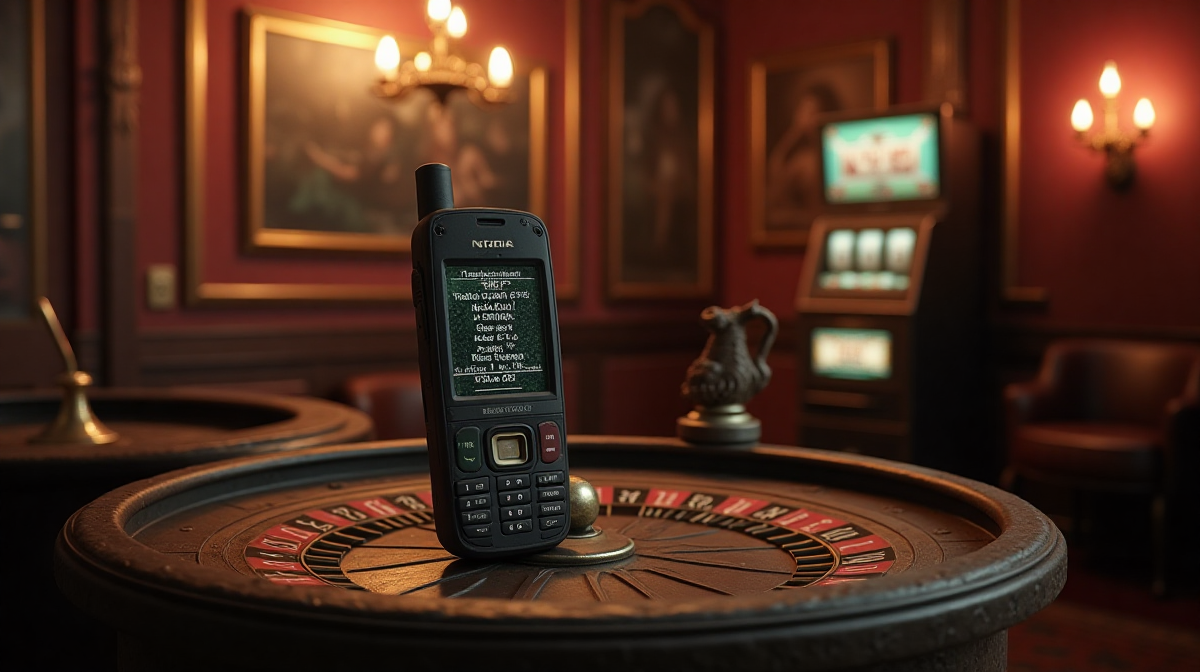Old Mobile Betshop: A Nostalgia Trip?
Setting the Scene: Early Mobile Technology & Gambling
The early 2000s were a period of rapid technological advancement, and mobile phones were at the forefront. While not the smartphones we know today, these devices were beginning to offer capabilities beyond just voice calls and SMS messaging. Simultaneously, the gambling industry was recognizing the potential of reaching a wider audience through this new mobile channel. This convergence of factors led to the birth of the “old mobile betshop,” a rudimentary but revolutionary way to place bets on the go. This era predates the seamless experience of modern apps and high-speed data, and many will remember the struggle, and the thrill, of those early bets.
Introducing the Old Mobile Betshop – What Defined It?
The term “old mobile betshop” evokes a specific time – a period dominated by Wireless Application Protocol (WAP) and SMS betting. Before native apps, WAP was the primary method for accessing internet-based services on mobile phones. This meant navigating clunky, text-heavy websites designed for tiny screens. Alternatively, SMS betting allowed users to place bets by sending text messages containing specific codes. This was incredibly simple, but also limited in terms of information display and bet types. Considering current options like knowing how to win aviator game on sportybet, the difference is stark.
Hook: Appealing to Nostalgia - Who Remembers…?
Do you remember painstakingly navigating a WAP site to place a football bet? Or the anticipation of waiting for an SMS confirmation after sending a code? For many, the old mobile betshop represents a simpler time, a pioneering era of mobile gambling. It was a time when accessing betshop com on your phone felt like a genuine innovation, a glimpse into the future. This article aims to revisit that era, exploring the technology, the key players, and the unique user experience of early mobile betting.
A Deep Dive into the Technology of Yesterday’s Mobile Betting
WAP – The King of Early Mobile Internet
WAP was the standard for accessing internet services on mobile phones before the widespread adoption of smartphones. It provided a limited version of the web, optimized for the constraints of early mobile devices. While it allowed access to services like email and, crucially, mobile betting, it came with significant limitations.
Limitations of WAP: Speed, Usability, Graphic Capabilities
WAP connections were notoriously slow, even with 2G networks. Pages loaded slowly, and the user interface was often clunky and difficult to navigate. Graphic capabilities were extremely limited, meaning websites were primarily text-based. This made finding desired markets or even understanding odds a frustrating experience.
Common WAP Betting Interface Features
Despite its limitations, WAP betting interfaces typically included features like basic market listings, odds displays, and bet placement forms. However, these were often presented in a very basic format, requiring users to navigate through multiple pages to complete even simple tasks. Navigation was often based on numerical menus and limited search functionality.
SMS Betting: Simplicity and Accessibility
SMS betting offered a more streamlined, if less visually appealing, alternative to WAP. It was particularly popular due to its simplicity and accessibility, requiring only a mobile phone capable of sending and receiving text messages.
How SMS Betting Worked: Sending Codes & Receiving Results
Users would typically send a text message containing a specific code corresponding to the desired bet to a designated shortcode. The bookmaker would then process the bet and send an SMS confirmation. Results were also often delivered via SMS.
Advantages & Disadvantages of SMS-Based Wagering
The main advantage of SMS betting was its ease of use and accessibility. However, it was limited in terms of bet types and the amount of information that could be conveyed. It also lacked the visual feedback of a WAP interface, making it harder to confirm bet details. This is a far cry from the complexities of games like Aviator, and questions like who is the owner of aviator game weren’t commonly asked in those days.
Mobile Handsets of the Era: Nokia, Motorola, and Beyond
The mobile phones of the early 2000s were vastly different from the smartphones we use today. Brands like Nokia and Motorola dominated the market, offering devices with limited capabilities.
The Role of Phone Capabilities
Screen size was a major limiting factor, making it difficult to display complex information. Memory was also limited, which impacted the performance of WAP browsers. Data connectivity, typically through 2G networks, was slow and unreliable.
Impact of Different Operating Systems
Before the advent of iOS and Android, mobile phones ran on a variety of proprietary operating systems, each with its own limitations. These operating systems often lacked the features and functionality necessary to support more sophisticated mobile applications.
Key Players in the Early Mobile Betshop Landscape
Identifying the Pioneering Betting Companies
Major bookmakers like Ladbrokes, William Hill, and Coral were among the first to embrace mobile betting. They recognized the potential to reach a new audience and increase their market share.
Early Mobile Betting Strategies of Major Bookmakers
These companies initially focused on offering basic betting options through WAP and SMS. They often promoted their mobile services through traditional advertising channels, highlighting the convenience of betting on the go. Many also integrated betshop branding into their early mobile offerings.
Marketing and Promotion of Mobile Betting Services
Marketing efforts centered around the novelty and convenience of mobile betting. Advertisements emphasized the ability to place bets anytime, anywhere. Often, promotions included incentives to try the new mobile services.
Specialized Mobile Betting Providers
While the major bookmakers dominated the market, several smaller, specialized mobile betting providers also emerged. These companies often focused on specific niches, such as sports betting or horse racing.
The Role of Technology Providers: Powering the Platforms
Behind the scenes, technology providers played a crucial role in powering the early mobile betshop platforms. These companies developed the WAP gateways and SMS infrastructure that enabled mobile betting.

The User Experience: What Was It Really Like?
Navigating Clunky Interfaces: Challenges & Frustrations
The user experience of the old mobile betshop was often frustrating. WAP interfaces were slow, difficult to navigate, and lacked the visual appeal of modern websites. Users had to contend with small screens, limited functionality, and constant loading times.
Data Costs & Restrictions: A Significant Barrier to Entry
Data costs were significantly higher in the early 2000s, making mobile internet access expensive. Many users had limited data plans, which restricted their ability to browse WAP sites or send SMS messages. This was a major barrier to entry for many potential mobile bettors.
Security Concerns in the Early Days of Mobile Transactions
Security was also a concern in the early days of mobile transactions. Mobile networks were less secure than modern networks, and there was a risk of interception of sensitive data. However, the draw of accessibility to a betshop com service often outweighed these concerns.
The Appeal Despite the Challenges: Convenience & Novelty
Despite the challenges, the old mobile betshop held a certain appeal. The convenience of being able to place bets on the go was a major draw. The novelty of mobile betting also attracted many users.
The Transition to Smartphones & Modern Mobile Betting
The iPhone Revolution & the Dawn of Native Apps
The launch of the iPhone in 2007 marked a turning point in the mobile industry. It ushered in the era of smartphones and native apps, which offered a vastly improved user experience compared to WAP and SMS betting.
Impact of 3G & 4G Networks: Speed & Data Accessibility
The rollout of 3G and 4G networks dramatically increased mobile internet speeds and reduced data costs. This made mobile betting more accessible and enjoyable for a wider audience.
UX Improvements: From WAP to Intuitive Apps & Mobile Websites
Native apps and mobile websites offered a much more intuitive and user-friendly experience than WAP sites. They featured improved graphics, faster loading times, and a wider range of betting options.
The Evolution of In-Play Betting and Live Streaming
The advent of smartphones and faster data speeds also enabled the evolution of in-play betting and live streaming. These features added a new level of excitement and engagement to the mobile betting experience.

A Nostalgic Look Back – Why Do We Remember?
The Simplicity & Charm of Early Mobile Betting
Despite its limitations, the old mobile betshop had a certain simplicity and charm. It was a time when mobile betting felt like a genuine innovation, a glimpse into the future.
The “First Time” Experience: A Sense of Innovation
Many users remember the “first time” experience of placing a bet on their mobile phone. It was a sense of liberation and empowerment, the ability to bet on the go without having to visit a physical betshop.
Community & Discussions Around Early Mobile Betting
Online forums and word of mouth played a significant role in spreading the word about mobile betting. Users shared tips, strategies, and experiences with each other, creating a sense of community.
The Contrast with Today’s Sophisticated Mobile Platforms
Looking back, the contrast between the old mobile betshop and today’s sophisticated mobile platforms is stark. Modern mobile betting apps offer a seamless and immersive experience, with a vast range of features and options.
Conclusion: The Legacy of the Old Mobile Betshop
How Early Mobile Betting Paved the Way for Today’s Industry
The old mobile betshop played a crucial role in paving the way for today’s mobile betting industry. It demonstrated the viability of mobile gambling and laid the foundation for the innovations that followed.
Is There Room for a “Retro” Mobile Betting Experience?
While unlikely, there is a certain nostalgic appeal to the simplicity of the old mobile betshop. A “retro” mobile betting experience, perhaps emulating the look and feel of WAP sites, could be a fun novelty for some users.
Final Thoughts - A Lost Era of Mobile Gambling?
The old mobile betshop represents a lost era of mobile gambling. It was a time of experimentation, innovation, and a certain degree of frustration. However, it was also a time that laid the groundwork for the multi-billion dollar mobile betting industry we know today. The evolution from struggling with a basic WAP interface to easily accessing platforms to understand old mobile betshop odds demonstrates how far technology has come.

